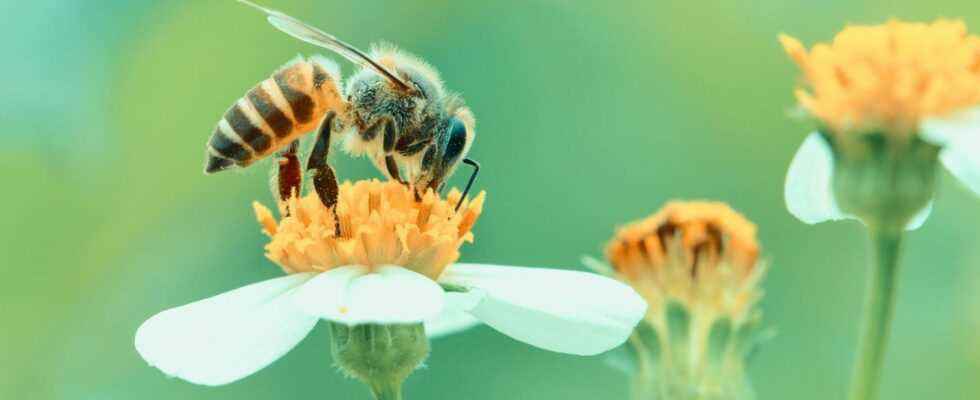bee deaths
Here’s how you can help bees in need
© herain kanthatham / Shutterstock
Save our bees! Everyone is talking about the death of bees – do we have to fear that we will soon run out of honey? And how can we help bees in need? We have the answers!
Everyone is talking about bee deaths – what’s behind it?
The world bee population has been declining for several years. Experts fear that bee deaths far-reaching consequences for other insect species, animals and us humans. bees pollinate many plantsthat for one most of our food are needed.
Without the small pollinators, there would be no apples and tomatoes, but also no products with rapeseed or sunflower oil, to name just a few examples. Insects are an important pillar of the plant world and therefore also of our food.
What does this mean for our honey?
When we hear “bees” we first think of juicy honeycomb and sweet honey. So is the global supply of honey also at risk?
No! Because what only a few are aware of: are on the verge of extinction especially wild bee species threatened. However, honey bees are livestock, which are kept and cared for by beekeepers. As long as beekeepers decide to have honey produced, honey bees have a job and a livelihood. In this way, typical winter losses can also be compensated for: by breeding entire bee colonies.
What causes bee deaths?
are wild bees threatened by several factors – and not all start from people. For example, the so-called Varroa mite (Varroa destructor) established in recent years as one of the largest natural bee killers. The small mite measures just under one and a half millimeters and can kill entire bee colonies.
But also toxins, for example sprayed by farmers are triggers of bee mortality. For example, weed killers harm the insects because they take the plants away from them to pollinate. However, some insect killers that are deadly to bees are also used.
Especially fatal to wild bees are so-called neonicotinoids, “neonics” for short, which can be easily sprayed and are very effective in destroying insects – imidacloprid in particular is one of the causes of bee deaths. Some of the neonics were recently banned in the EU, but instead farmers are now spraying with other, no less dangerous poisons.
Advances in agriculture and increasing human efficiency also pose a threat to bees. monocultures and well-designed green areas make it difficult for the animals to find food. Many insects simply starve to death because they lack the diversity and bounty of a wilderness.
How can I help bees in need?
If you have one in the summer bee in distress – for example on the balcony or in the garden – it is probably exhausted from searching for nectar and can no longer fly. She is now in danger of starving but you can you them pick up with simple means and give her new strength:
- shuffle one small amount of sugar and water in a ratio of 3:2 – the sugar must have completely dissolved.
- The sugar water can Energize beesso they can keep flying. To do this, pour the mixture into a small container that is easy for them to drink from.
- Suitable drinking vessels: Upturned beer bottle caps, empty tablet blister packs, teaspoons (only partially filled). Upside-down Lego bricks are also often used to water the weakened bees – the advantage here is that the little animals can absorb the sugar water well, but not drown in it.
- Now make the sugar water available to the insects. See if they manage to consume the “energy drink” and make sure they don’t drown in the sugar solution.
Of course you can too bee waterer build where the hard-working pollinators get simple water to drink.
Important: Because Bees can’t swim, they need shallow access to the water or a place to land. Classic bee waterers consist of a bowl of marbles that is filled with water to such an extent that the marbles stick out of the water and the animals can land on them.
You can also make life easier for wild bees in general. With just a few simple steps, you can help ensure that they have a better life in your neighborhood. This includes:
- plant one wild flower mix: Bees need pollination material that they lack in our elaborate gardens and meticulously laid beds. (“How flowers can save the world“)
- Let five be straight: a little too clutter in the garden makes life easier for bees. Staggered stones or corners with pieces of wood create cavities into which the little animals can withdraw. Deadwood can also be left behind, piles of gravel or stones also serve a purpose.
- wilderness and weeds: Yes, that’s nature! If we keep tearing out or pruning “unwanted” plants, we take away the habitat of the bees. Just let it grow – the insects will thank you. (And if you don’t think a “wild garden” is beautiful, you might be able to let at least one corner of the lot grow wild – better than nothing).
- Set up or hang up an insect hotel: Here, too, insects benefit from cavities in which they move can withdraw.
- Plant your own plants that are good for bees: lavender and thyme for example, our flying friends offer lots of tasty nectar and give them lots of vigor – unlike some sterile flowers that “just look nice”. We will show you how you can plant lavender yourself and what you need to consider when planting thyme. Maybe you’ll enjoy growing herbs…
You can find more ideas for garden design in our special. And: You can find more tips about the balcony and garden on our Pinterest board – have a look!


